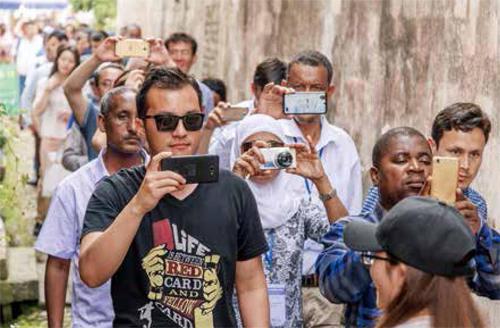钱江潮涌新时代
2018-09-06洪徐
洪徐
盛夏钱塘,十里荷香。
15年前,“八八战略”提出:“进一步发挥浙江的人文优势,积极推进科教兴省、人才强省,加快建设文化大省。”15年来,从文化大省、文化强省到文化浙江,文化建设的步伐稳步推进,传统与现代兼具的软实力日益彰显,不断创新的“浙江精神”与时俱进再谱新篇。
盛世钱塘,潮涌东方。
钱塘江是浙江的母亲河。许多有识之士认为,走在前列的浙江,努力将钱塘江流域打造成在国际国内更具竞争力、影响力、创造力的文化高地和文化发展大平台,让这条浙江的母亲河更具文化氛围、更有文化气息、更富文化内涵,让生长、生活在全流域的人民群众有更多的文化获得感和幸福感。这是文化浙江建设的应有之义。
钱塘自古繁华
浩浩荡荡700公里,绵绵延延5.6万平方公里。钱塘江是一部流动的遗产,也是一段活着的历史。
江河一旦与文化融合,必定产生不朽的力量。从远古奔流到时代潮涌,钱塘江代表着勇往直前、敢于拼搏的弄潮儿精神。千百年来不息流淌的钱塘江,给浙江人民留下的不仅是富庶的生活印记,更有不朽的钱塘风雅。如今,漫步在钱塘江两岸,游客惬意,民生幸福,百姓安康。
“八月十八潮,壮观天下无。”地处钱塘江北岸腹地的杭州市江干区,自古就是繁华商埠和交通要地,素有“钱塘江畔金江干”美誉。这里的人们世代临水而居,创造了灿烂的钱塘江文化:不仅孕育了“江、河、山、茶、丝、孝”等特色文化,弄潮文化、治水文化、围垦文化、航空文化、航运文化、民俗文化百花绽放,也培育出明代功臣胡世宁、浙派画宗戴进、电影先驱夏衍等一批杰出人物;“杭罗织造技艺”入选联合国人类非遗代表作名录,钱塘江传说、皋亭山传说、江干剪纸被列入省级非遗名录;区域内还保存有古海塘、渡口、船埠等历史遗迹,三堡船闸、四季青碑亭和明清古海塘成为钱塘江沧桑巨变的历史再现。
东南形胜,三吴都会,钱塘自古繁华;烟柳画桥,风帘翠幕,参差十万人家。钱塘江流经浙江近一半的省域面积。在漫长的历史长河中,钱塘江孕育了“勇立潮头、大气开放、互通共荣”的先进文化,引领人们开荒拓土、激流勇进,建设美丽富饶、人皆向往的鱼米之乡、丝绸之府和诗画江南,铸造了钱塘自古繁华的华丽史诗。
据浙江省钱塘江文化研究会发布的《钱塘江流域文化产业报告》显示,改革开放40年来,浙江的文化产业持续增长,逐渐发展为支柱产业。2016年全省文化及相关特色产业增加值3232.98亿元,占GDP6.84%。中国省市文化产业发展综合指数和生产力指数均列上海、北京、江苏之后居全国第四位,影响力指数居第三位。以杭州、嘉兴、绍兴、金华、衢州、丽水6个设区市50县为主体的钱塘江流域构成浙江重要的文化产业带,2016年文化及相关特色产业增加值占全省65.28%,成为新时代浙江文化产业发展的新空间、新动能。
如今,钱塘江流域文化产业特色优势日益凸显,资源集聚功能增强,要素支撑强化,发展模式改良,政策环境优化,正在进入质量提升的新阶段。
从“西湖时代”走向“钱塘江时代”
“钱塘江畔的视野给人以无穷的灵感。”中国美术学院中德学院国际品牌传播外籍教师大卫·杜蒙特这样概括钱塘江的魅力。他说,当他两个月前第一次来到中国,对中国还知之甚少,更不了解杭州和钱塘江区域。当他到达上海浦东机场驱车到杭州,走出车子,身处钱塘江区域,奥体中心就在江的对岸,他被深深地震撼了:高大、崭新、耀眼的建筑群,宽阔的马路,有组织的交通,一切井然有序。
不久前举办的第二届钱塘江文化节大型音画组歌《钱塘词画》首次公演,作为杭州市政府聘请的杭州文艺顾问,朱海记忆犹新,“如果说西湖蕴含了杭州唯美精致的品质,那么钱塘江就是我们杭州人乃至浙江人的精神所在。”
国家一级演员、海政文工团青年歌唱家吕薇是《望海潮·东南形胜》的演唱者,作为杭州人,她难掩激动。“这次演绎将钱塘江深厚的文化底蕴与历史巨变结合起来,可以说是历久弥新。我也希望能以这首歌为载体,帮助现代人感受传统文化,体悟錢塘江文化的魅力。”
“钱塘江象征着我们文化的源远流长,尤其是那一句‘千年潮,天地行,潮起在之江,一下子把我们的历史文化通过歌词唱了出来,也象征着这一文化必将走向国际。”世界著名男高音歌唱家张建一表示。
钱塘江浸润着文人墨客的情怀,奔涌着“创新、进取”的时代内涵。
“2018钱塘江流域文化产业发展大会”6月28日在杭州举行,大会发布“传承钱塘江文化 共推文化产业新发展”倡议书,又一次展开了钱塘江文化产业发展蓝图:钱塘江流域要成为浙江文化产业发展示范区、文化创意实验区、文化产业融合发展集成区、文化产业要素集聚区、文化产业国际化展示区。
不久前,浙江省政府发布《之江文化产业带建设规划》,一项计划总投资超过1000亿元,覆盖钱塘江杭州段沿线9个县(市、区)的重大文化项目集群亮相于钱塘江两岸,并陆续开工建设。其中,有数字文化产业领域重点项目13个,影视文化产业领域重点项目7个,艺术创作设计产业领域重点项目8个,动漫游戏产业领域重点项目4个……
一项项具体任务,一个个明确目标,一幅幅美好蓝图,从“西湖时代”到“钱塘江时代”,文化浙江的定义在不断凝练、不断拓展。
从“跨江发展”到“拥江发展”
文化是一个城市的灵魂和生生不息的动力。
自G20杭州峰会成功举办,位于钱塘江入海口的江干区,用钱塘江文化提升城市品位,成为杭州实施“拥江布局、一体发展”新发展战略的主战场。
钱塘江流域主要涉及浙江6个地级市。如何让这流经浙江47%的实域面积的文化力量,在新时代更好地薪火相传?钱塘江文化如何在传承中创新、在创新中提升、在提升中发展?
杭州市委常委、宣传部部长戚哮虎提出,要打造具有国际影响力的全国文创中心,全面推进之江文化产业带建设,为钱塘江流域文化产业发展提供坚实基础和有力保证。
嘉兴是有着7000多年文明史、2500多年文字记载史、1700多年建城史的国家历史文化名城。嘉兴市委常委、宣传部部长祝亚伟表示,要把文化产业打造成为嘉兴率先基本实现现代化的“新支柱”“新引擎”,力争到2020年,全市文化产业产值达到1100亿元,占GDP的7%以上,成为国民经济重要支柱产业。
绍兴市委宣传部副部长黄爱芬表示,要做好“文化+”文章,提出“拥抱大湾区、发展大绍兴”的发展战略,正是从“会稽山时代”迈向“杭州湾时代”的时代要求,力争到2020年,全市实现文化产业增加值400亿元以上,占GDP比重达到8%左右,产业发展活力和文化引领等指标位居全省前列。
衢州市委常委、宣传部部长钱伟刚认为,作为钱塘江源头的衢州,要从“衢江时代”奔向“钱塘江时代”,让钱塘江唐诗之路更加诗意盎然,让传承自“孔洙让爵”的“衢州有礼”成为新时代衢州发展最强劲的文化动力。
丽水市委常委、宣传部部长葛学斌建议,加强钱塘江流域文化产业一盘棋规划,根据各地发展的基础和条件,进行不同定位,合理配置要素资源。要建立和完善区域文化产业发展协调联动机制,加快跨区域协同创新机制建设,更好地推进文化产业的合理布局与分工。
在金华市委宣传部副部长曹一勤看来,金华是一座有历史、有文化、有故事的城市。金华市的文化产业是有特色、有底蕴、有后劲的支柱产业。2017年,金华文化影视时尚产业实现营收4188.5亿元,同比增长10.2%,总量排名全省第三,为全省文化产业走在全国前列贡献了金华力量。
千年潮,天地行,潮起之江;弄潮儿,涛头立,翘首东方。
从钱塘江上游的“衢江万古身潺湲”到下游的“海阔天空浪若雷”,站在历史的新起点,钱塘江两岸人民正以引领潮流的气魄、大气包容的心态、联通世界的胸襟、勇立潮头的干劲,谱写一曲风雅钱塘新时代的乐章。
钱塘自古繁华。从“西湖时代”到“钱塘江时代”,從“跨江发展”到“拥江发展”,文化浙江将从钱塘江再次扬帆起航。
New Development Era
on the Qiantang River
By Hong Xu
A review of the history of Zhejiang in eastern China reveals a galaxy of celebrities, economic and cultural prosperities, a peaceful life, a great variety of cultural heritage, let alone numerous poems and essays, paintings and other artistic achievements. All this largely happened in the regions, part of the Qiantang, the mother river of the province.
A review of the present-day situation of the province will point to a thriving cultural industry along the Qiantang. Over the past 40 years, the cultural industry of Zhejiang has grown into a pillar of the provincial economy. In 2016, the value added of the provinces cultural and relevant industries amounted to 323.298 billion yuan, accounting for 6.84% of the provinces GDP, ranking number 4 behind Shanghai, Beijing and Jiangsu. The river valley, which covers 6 major cities and 50 counties, constitutes a key belt of the cultural industry. In 2016, the value added of the cultural and related industries accounted for 65.2 % of the provincial total.
Nowadays, the cultural industry in the river drainage system is going into a new developmental era: with industrial strengths, resources, preferential policies, and an improved growth mode, etc. The new era is directly named after the Qiantang in comparison with the West Lake Era.
On June 28, 2018, Hangzhou hosted a large-scale convention on the development of the cultural industry in the Qiantang River Valley. An ambitious blueprint launched at the convention lists six zones with different focuses. On June 26, the provincial government announced a 100 billion investment plan for the cultural industry in the nine counties and urban districts in the Hangzhou Section of the Qiantang. The investment goes into 13 projects in the digital production section, 7 in the film and television section, 8 in the art and design industry, and 4 in the cartoon and animation industry.
The G20 Hangzhou Summit in September 2016 marked a turning point in the urban development of Hangzhou. Since then, the districts along the river have greatly enhanced themselves as the citys blueprint emphasizes integrated growth.
Zhu Yewei, a government official of Jiaxing, a central city in northern Zhejiang, reveals that the cultural industry of Jiaxing strives to produce an output of 110 billion yuan next year to account for at least 7% of the citys GDP. If this goal is achieved, the cultural industry will be a pillar of the citys economy.
Huang Aifen, a government official of Shaoxing, a city in eastern Zhejiang, said that Shaoxing is embracing the macro-economic growth of the Hangzhou Bay. The cultural industry of the city strives to produce a value added of 40 billion yuan by 2020, which will be 8% of Shaoxings GDP.
Cao Yiqin, a government official of Jinhua, a key city in central Zhejiang, remarked that Jinhua is a city of history, culture and stories. The citys cultural industry has long been a pillar of the local economy. In 2017, the cultural industry (including the sectors of culture, movie and television, and fashion) accomplished a total income of 438.85 billion yuan, achieving an increase of 10.2% year on year and ranking the third in the province. Cao remarked proudly that Jinhua contributes significantly to the provinces cultural industry which leads the country.
If Quzhou in the southwest of the province cant contribute a great deal to the provinces cultural industry, the city can certainly contribute magnificently to culture as the city is home to Confucius Family Temple and Residence in the South, which was founded in the Southern Song Dynasty (1127-1279). The unique glorious site represents a force of the traditional culture.
Ge Xuebin, a government official of Lishui, a city in the south of Zhejiang, emphasizes a plan for integrated growth of the cultural industry in the river basin. Apparently, the city hopes to merge into the provincial growth through such an integrated system.
A review of the history of Zhejiang in eastern China reveals a galaxy of celebrities, economic and cultural prosperities, a peaceful life, a great variety of cultural heritage, let alone numerous poems and essays, paintings and other artistic achievements. All this largely happened in the regions, part of the Qiantang, the mother river of the province.
A review of the present-day situation of the province will point to a thriving cultural industry along the Qiantang. Over the past 40 years, the cultural industry of Zhejiang has grown into a pillar of the provincial economy. In 2016, the value added of the provinces cultural and relevant industries amounted to 323.298 billion yuan, accounting for 6.84% of the provinces GDP, ranking number 4 behind Shanghai, Beijing and Jiangsu. The river valley, which covers 6 major cities and 50 counties, constitutes a key belt of the cultural industry. In 2016, the value added of the cultural and related industries accounted for 65.2 % of the provincial total.
Nowadays, the cultural industry in the river drainage system is going into a new developmental era: with industrial strengths, resources, preferential policies, and an improved growth mode, etc. The new era is directly named after the Qiantang in comparison with the West Lake Era.
On June 28, 2018, Hangzhou hosted a large-scale convention on the development of the cultural industry in the Qiantang River Valley. An ambitious blueprint launched at the convention lists six zones with different focuses. On June 26, the provincial government announced a 100 billion investment plan for the cultural industry in the nine counties and urban districts in the Hangzhou Section of the Qiantang. The investment goes into 13 projects in the digital production section, 7 in the film and television section, 8 in the art and design industry, and 4 in the cartoon and animation industry.
The G20 Hangzhou Summit in September 2016 marked a turning point in the urban development of Hangzhou. Since then, the districts along the river have greatly enhanced themselves as the citys blueprint emphasizes integrated growth.
Zhu Yewei, a government official of Jiaxing, a central city in northern Zhejiang, reveals that the cultural industry of Jiaxing strives to produce an output of 110 billion yuan next year to account for at least 7% of the citys GDP. If this goal is achieved, the cultural industry will be a pillar of the citys economy.
Huang Aifen, a government official of Shaoxing, a city in eastern Zhejiang, said that Shaoxing is embracing the macro-economic growth of the Hangzhou Bay. The cultural industry of the city strives to produce a value added of 40 billion yuan by 2020, which will be 8% of Shaoxings GDP.
Cao Yiqin, a government official of Jinhua, a key city in central Zhejiang, remarked that Jinhua is a city of history, culture and stories. The citys cultural industry has long been a pillar of the local economy. In 2017, the cultural industry (including the sectors of culture, movie and television, and fashion) accomplished a total income of 438.85 billion yuan, achieving an increase of 10.2% year on year and ranking the third in the province. Cao remarked proudly that Jinhua contributes significantly to the provinces cultural industry which leads the country.
If Quzhou in the southwest of the province cant contribute a great deal to the provinces cultural industry, the city can certainly contribute magnificently to culture as the city is home to Confucius Family Temple and Residence in the South, which was founded in the Southern Song Dynasty (1127-1279). The unique glorious site represents a force of the traditional culture.
Ge Xuebin, a government official of Lishui, a city in the south of Zhejiang, emphasizes a plan for integrated growth of the cultural industry in the river basin. Apparently, the city hopes to merge into the provincial growth through such an integrated system.
